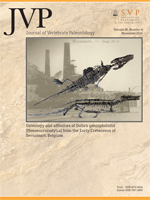Sabinosuchus coahuilensis, n. gen. et sp., is a marine crocodyliform from the Upper Cretaceous Sauz Creek Member or lower part of the Cuevas Creek Member of the Escondido Formation (Maastrichtian) near Sabinas in Coahuila, Mexico. The type specimen exhibits two synapomorphies of family Dyrosauridae: dentary alveolus 7 is reduced in size compared with the eighth, and the mandibular symphysis is nearly as wide as it is high for most of its length. Sabinosuchus coahuilensis is distinguished from all other known members of Dyrosauridae on the basis of three autapomorphic traits: the posterior section of the mandible is distinctly broad and flat, the mandibular rami are considerably longer than the symphysis, and the posterior mandibular alveoli are uniquely arranged. Sabinosuchus coahuilensis joins Hyposaurus rogersii as the second known North American dyrosaurid. Although the two were contemporaneous, they differed notably in rostrum length and shape; S. coahuilensis has a relatively shorter rostrum with a much wider and flatter posterior mandibular symphysis. Phylogenetic analyses and biostratigraphy suggest that S. coahuilensis occupies a basal position in Dyrosauridae.
How to translate text using browser tools
1 November 2016
Sabinosuchus coahuilensis, A New Dyrosaurid Crocodyliform from the Escondido Formation (Maastrichtian) of Coahuila, Mexico
Thomas A. Shiller,
Hector G. Porras-Muzquiz,
Thomas M. Lehman
ACCESS THE FULL ARTICLE





